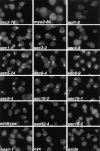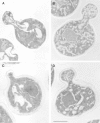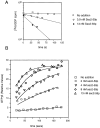Sec2p mediates nucleotide exchange on Sec4p and is involved in polarized delivery of post-Golgi vesicles
- PMID: 9199166
- PMCID: PMC2137815
- DOI: 10.1083/jcb.137.7.1495
Sec2p mediates nucleotide exchange on Sec4p and is involved in polarized delivery of post-Golgi vesicles
Abstract
The small GTPase Sec4p is required for vesicular transport at the post-Golgi stage of yeast secretion. Here we present evidence that mutations in SEC2, itself an essential gene that acts at the same stage of the secretory pathway, cause Sec4p to mislocalize as a result of a random rather than a polarized accumulation of vesicles. Sec2p and Sec4p interact directly, with the nucleotide-free conformation of Sec4p being the preferred state for interaction with Sec2p. Sec2p functions as an exchange protein, catalyzing the dissociation of GDP from Sec4 and promoting the binding of GTP. We propose that Sec2p functions to couple the activation of Sec4p to the polarized delivery of vesicles to the site of exocytosis.
Figures










Similar articles
-
Ypt32 recruits the Sec4p guanine nucleotide exchange factor, Sec2p, to secretory vesicles; evidence for a Rab cascade in yeast.J Cell Biol. 2002 Jun 10;157(6):1005-15. doi: 10.1083/jcb.200201003. Epub 2002 Jun 3. J Cell Biol. 2002. PMID: 12045183 Free PMC article.
-
The role of the COOH terminus of Sec2p in the transport of post-Golgi vesicles.J Cell Biol. 2000 Apr 3;149(1):95-110. doi: 10.1083/jcb.149.1.95. J Cell Biol. 2000. PMID: 10747090 Free PMC article.
-
Interactions of nucleotide release factor Dss4p with Sec4p in the post-Golgi secretory pathway of yeast.J Biol Chem. 1997 Jul 18;272(29):18281-9. doi: 10.1074/jbc.272.29.18281. J Biol Chem. 1997. PMID: 9218467
-
The cycle of SEC4 function in vesicular transport.Ciba Found Symp. 1993;176:218-28; discussion 229-32. Ciba Found Symp. 1993. PMID: 8299422 Review.
-
Small GTP-binding proteins and their role in transport.Curr Opin Cell Biol. 1991 Aug;3(4):626-33. doi: 10.1016/0955-0674(91)90033-u. Curr Opin Cell Biol. 1991. PMID: 1663370 Review. No abstract available.
Cited by
-
Spitzenkorper, exocyst, and polarisome components in Candida albicans hyphae show different patterns of localization and have distinct dynamic properties.Eukaryot Cell. 2010 Oct;9(10):1455-65. doi: 10.1128/EC.00109-10. Epub 2010 Aug 6. Eukaryot Cell. 2010. PMID: 20693302 Free PMC article.
-
Cyclin-dependent kinase-mediated phosphorylation of the exocyst subunit Exo84 in late G1 phase suppresses exocytic secretion and cell growth in yeast.J Biol Chem. 2019 Jul 19;294(29):11323-11332. doi: 10.1074/jbc.RA119.008591. Epub 2019 Jun 6. J Biol Chem. 2019. PMID: 31171719 Free PMC article.
-
The Role of Secretory Pathways in Candida albicans Pathogenesis.J Fungi (Basel). 2020 Feb 24;6(1):26. doi: 10.3390/jof6010026. J Fungi (Basel). 2020. PMID: 32102426 Free PMC article. Review.
-
Phosphorylation provides a negative mode of regulation for the yeast Rab GTPase Sec4p.PLoS One. 2011;6(9):e24332. doi: 10.1371/journal.pone.0024332. Epub 2011 Sep 12. PLoS One. 2011. PMID: 21931684 Free PMC article.
-
Ypt/Rab GTPases: principles learned from yeast.Crit Rev Biochem Mol Biol. 2015;50(3):203-11. doi: 10.3109/10409238.2015.1014023. Epub 2015 Feb 23. Crit Rev Biochem Mol Biol. 2015. PMID: 25702751 Free PMC article. Review.
References
Publication types
MeSH terms
Substances
Grants and funding
LinkOut - more resources
Full Text Sources
Molecular Biology Databases

